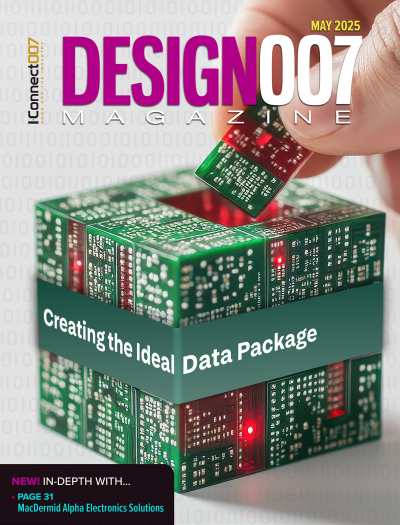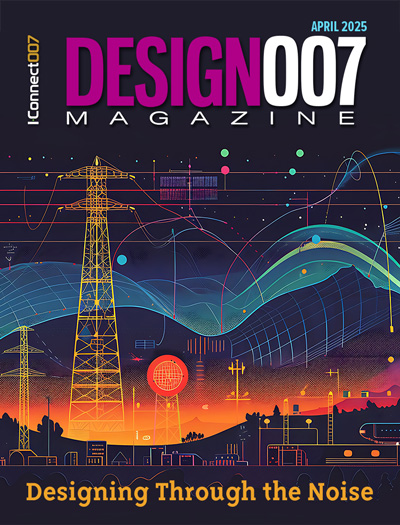-

- News
- Books
Featured Books
- design007 Magazine
Latest Issues
Current Issue
Creating the Ideal Data Package
Why is it so difficult to create the ideal data package? Many of these simple errors can be alleviated by paying attention to detail—and knowing what issues to look out for. So, this month, our experts weigh in on the best practices for creating the ideal design data package for your design.

Designing Through the Noise
Our experts discuss the constantly evolving world of RF design, including the many tradeoffs, material considerations, and design tips and techniques that designers and design engineers need to know to succeed in this high-frequency realm.

Learning to Speak ‘Fab’
Our expert contributors clear up many of the miscommunication problems between PCB designers and their fab and assembly stakeholders. As you will see, a little extra planning early in the design cycle can go a long way toward maintaining open lines of communication with the fab and assembly folks.
- Articles
- Columns
Search Console
- Links
- Media kit
||| MENU - design007 Magazine
Faster Board Speeds Demand Constraint-Driven Design
June 19, 2018 | Ralf Bruening, ZukenEstimated reading time: 2 minutes
Do you still use Post-it Notes? Invented in 1979, this simple, yet incredibly powerful communication mechanism is still commonly found in engineering and design departments. Despite modern electronic communication, many companies still struggle to provide a replacement for their ease-of-use and versatility.
But, by changing the way an engineer designs electronics, by giving up the Post-it for passing requirements, change requests and constraints between engineers, design times can be shortened and product quality improved. Modern PCB design tools permit the definition of design constraints, including constraints relating to high-speed design and EMC, such as the topology of connections (routing pin sequence) or overshoot and timing budgets, for example.
These constraints become increasingly important as components and boards become faster and more complex. But it is hard to capture and use/obey these constraints consistently throughout the complete design process, bearing in mind that may contradict each other. The Post-it Note captures this idea particularly well. A brief sketch implicitly includes the constraints that the designer is working under, in a very concise form; however retaining and using this information later is extremely difficult.
Adaptive Design
Using these powerful constraint techniques can be a double-edged sword. While the design process is made much safer by including constraints, it is all too easy to over-constrain the design and make it impossible to complete routing and placement. Even paper design guidelines can make products uneconomic to produce unless a great deal of engineering knowledge is applied during the design. This means the design tool has to be adaptive—reacting to changes in the design as it progresses. Combining these elements is anything but trivial, but doing so allows the designer to converge on the optimum design in the first pass, rather than via multiple attempts.
In PCB design, attributes (or constraints) and rules have always existed, and designers have tried to achieve their design goals, especially with systems that are based around the raw attributes of the components in a design. But attributes (or properties) are essentially just data about the pins, components or tracking, while constraints are requirements that must be obeyed. Examples include the maximum delay, or an error marker, which must be flagged as functional or an operation may be at risk. These can simply be a function of the design attributes, but constraints are typically more complex nowadays and they sometimes relate to each other (e.g., in high-speed memory the relationship between the byte lanes and from the data/address signals to strobe and clock signals). Constraints must exist through the different stages of the design process, from schematic to placement to routing.
To read this entire article, which appeared in the May 2018 issue of Design007 Magazine, click here.
Suggested Items
New Companion Guide to ‘DFM Essentials’ Delivers Deeper, Practical PCB Design Insights
06/05/2025 | I-Connect007The Companion Guide to DFM Essentials: Tips for Designing for Manufacturing is now available for free download. Building on the popular Printed Circuit Designer’s Guide to... DFM Essentials, this new resource from American Standard Circuits and ASC Sunstone Circuits offers advanced, real-world guidance to help PCB designers streamline production and avoid costly pitfalls.
Cadence Extends Support for Automotive Solutions on Arm Zena Compute Subsystems
06/05/2025 | Cadence Design Systems, Inc.Cadence announced IP, design solution, and expert design services for software and Systems-on-Chip (SoCs) based on Arm® Zena™ Compute Subsystems (CSS), Arm’s first-generation CSS for automotive.
Orbel Corporation Integrates Schmoll Direct Imaging
06/04/2025 | Schmoll AmericaOrbel Corporation in Easton, PA, proudly becomes the first PCM facility in the U.S. equipped with Schmoll’s MDI Direct Imaging system. This installation empowers Orbel to support customers with greater precision and quality.
Target Condition: From Dream House to Drill Files
06/05/2025 | Kelly Dack -- Column: Target ConditionIf you caught the movie “Barbie,” you may have laughed at its over-the-top utopia where every day begins with perfect weather, perfect smiles, and a perfectly pink commute. But beyond the plastic glam, the film subtly critiques the illusion of perfection—a message that feels surprisingly relevant to the world of PCB design and manufacturing.
IPC Releases Latest Standards and Revisions Updates
06/05/2025 | IPCEach quarter, IPC releases a list of standards that are new or have been updated. To view a complete list of newly published standards and standards revisions, translations, proposed standards for ballot, final drafts for industry review, working drafts, and project approvals, visit ipc.org/status. These are the latest releases for Q1 2025.


